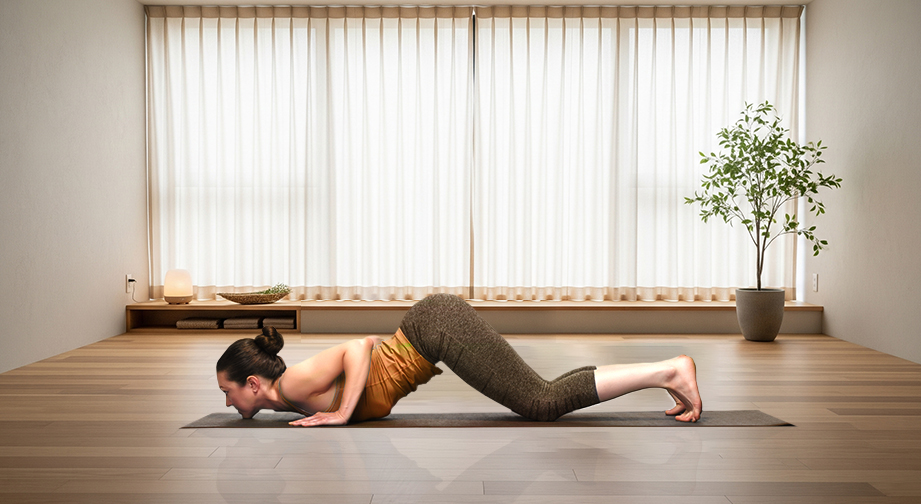Ashtanga Namaskara (Eight-Limbed Salutation Caterpillar – Reclining) Yoga Pose Guide
Introduction
Ashtanga Namaskara, also called the Eight-Limbed Salutation or sometimes Caterpillar Pose (Reclining), is a gentle yoga posture that forms a key part of the Sun Salutation sequence. In Sanskrit, "Ashtanga" means "eight limbs," and "Namaskara" means "salutation" — together, the name refers to bringing eight points of the body to the ground in a gesture of humble reverence.
Essence: Grounding, stabilizing, and deeply calming.
If you’ve ever felt stiff after sitting too long or want to build a solid foundation for your practice, Ashtanga Namaskara is your go-to pose. It’s gentle, approachable, and a great way to reconnect with your breath and body!
Step-by-Step Guide

- Start in Plank Pose: Begin on your mat in a strong plank position—hands under shoulders, body in a straight line.
- Lower Down with Control: As you exhale, bend your elbows and lower your knees, chest, and chin to the mat so that your toes, knees, chest, chin, hands, and feet all lightly touch the floor (the "eight limbs").
- Keep the Hips Lifted: Your hips should stay slightly lifted, not touching the mat.
- Hold the Pose: Breathe gently, keeping your gaze forward or down. Hold for 1–3 breaths.
- Release: On your next inhale, transition to Cobra Pose or return to Downward Facing Dog as part of your flow.
- Breathing: Exhale as you lower; inhale as you come out or move to the next pose.
- Duration: Hold 1–3 breaths for beginners; repeat for 2–3 rounds as comfortable.
- Modifications:
- For Beginners: Place a folded blanket under your knees or chest for support; lower one limb at a time.
- For Advanced Yogis: Try hovering the chest slightly above the mat for extra strength or hold the position longer for core engagement.
Alignment & Safety Tips
- Focus: Keep elbows close to the rib cage, shoulders away from ears.
- Common Mistakes: Dropping hips to the mat, flaring elbows, straining the neck. Avoid by moving slowly and checking alignment.
- Safety:
- Avoid if you’re pregnant, have wrist/shoulder injuries, or recent abdominal surgery.
- Always listen to your body and skip the pose if it causes pain.
Benefits
Physical Benefits:
- Strengthens arms, chest, shoulders, and core.
- Improves spinal flexibility.
- Stretches chest, back, and legs gently.
- Encourages better posture and alignment.
Mental Benefits:
- Grounds and calms the mind.
- Enhances focus and creates mindful transitions.
- Reduces stress and tension.
Energy / Chakra Connection:
- Activates the Solar Plexus (Manipura) Chakra, promoting confidence and inner strength.
- Balances energy through deliberate breath and grounding contact points.
Contraindications
- Avoid if you have wrist, elbow, or shoulder injuries.
- Contraindicated during pregnancy or recent abdominal surgeries.
- If you feel sharp pain or discomfort—pause and try alternatives like Cobra Pose (Bhujangasana) or Sphinx Pose (Salamba Bhujangasana).
Beginner’s Tips & Variations
- Props: Use a folded blanket under knees or a rolled towel under the chest for comfort and support.
- Gentle Variation: Lower knees, then chest, then chin one after the other instead of all at once.
- Advanced Variation: Hold the position longer, or try lowering with your body hovering just above the floor for extra strength-building.
How to Include in a Yoga Flow
Ashtanga Namaskara is best used as a transition in warm-up sequences like Sun Salutations (Surya Namaskar), or as a gentle strengthening move in your regular practice.
- Pairs well with poses like Plank Pose (Phalakasana), Cobra Pose (Bhujangasana), and Downward Facing Dog (Adho Mukha Svanasana).
- Try including it at the start of your practice to warm up and build confidence, or in the middle as a mindful pause.
Mind-Body Connection
While practicing Ashtanga Namaskara, focus on your breath, the sensation of each contact point, and the gentle flow of energy from head to toe. This asana encourages humility and mindfulness, and connects you to your inner balance. Traditionally, the eight limbs symbolize full surrender—a reminder to approach your practice (and life) with respect and care.
Asana Name: Ashtanga Namaskara (Eight-Limbed Salutation Caterpillar - Reclining)
Level: Beginner
Focus Areas: Arms, Chest, Core, Spine
Duration: 1–3 breaths per round; 2–3 rounds
Best Time to Practice: Morning or anytime as a transition in your flow
Frequently Asked Questions
Is Ashtanga Namaskara suitable for complete beginners?
Yes! It is a gentle and accessible asana for most people. Use props and take your time to learn the alignment.
Can I skip Ashtanga Namaskara in Sun Salutations?
Yes, you can substitute it with Cobra Pose or Sphinx Pose if lowering all eight points is uncomfortable for you.
How does Ashtanga Namaskara differ from Chaturanga Dandasana?
Ashtanga Namaskara touches knees, chest, and chin to floor (eight points); Chaturanga keeps the body in a straight line, hovering above the mat.